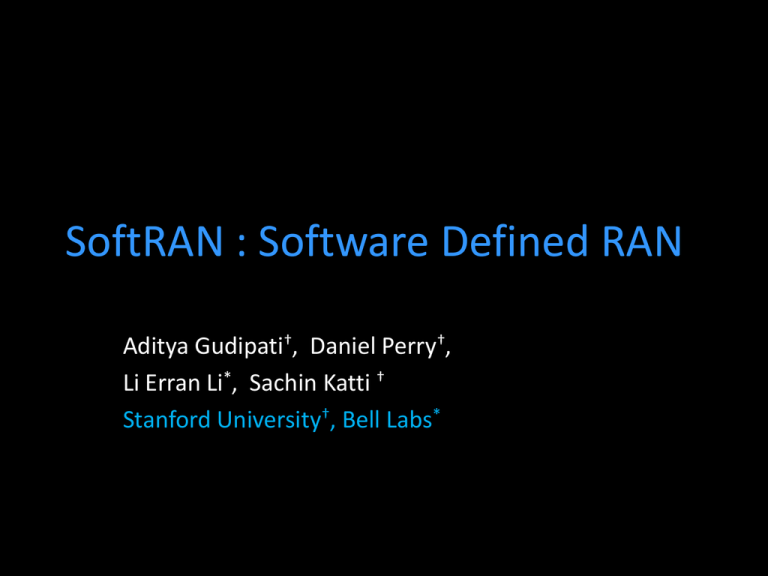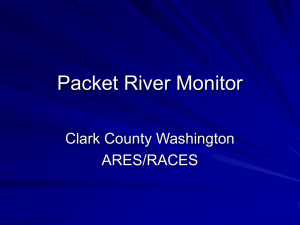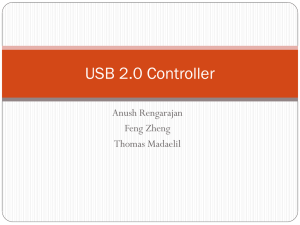Slides
advertisement

SoftRAN : Software Defined RAN Aditya Gudipati†, Daniel Perry†, Li Erran Li*, Sachin Katti † Stanford University†, Bell Labs* 2 LTE - Radio Access Network S-Gateway 1 Client1 BS1 Client2 Client3 P-Gateway BS2 BS3 I N T E R N E T S-Gateway 2 Client4 Core Network Radio Access Network High Capacity, Uniform Coverage Wide-Area Wireless Network 3 RAN Actions: Radio Resource Management 1. Assign each client to a base station Flow 1 Flow 2 dB time time dB dB dB dB frequency 2. Assign resource blocks (timefrequency slots) to each flow frequency 3. Assign transmit powers to be used for each resource block 4 RAN Challenges • Increasing demand on wireless resources – Dense deployments of small cells Radio Resource Management gets coupled across base stations 5 Coupled Radio Resource Management: Interference BS2 BS1 Client1 Client2 • Power used by BS1 affects interference at Client 2 • Interference at Client 2 affects power reqd. at BS2 6 Coupled Radio Resource Management: Mobility BS2 BS1 Client1 Client1 • Dense deployments – Higher frequency of handovers – More candidate base stations – Coordinating handovers critical 7 In dense deployments, Radio Resource Management needs to be tightly coordinated 8 LTE-RAN: Current Architecture • Distributed control plane • Tight coordination becomes infeasible with density – Huge demands on the backhaul network • Inefficient radio resource management • Hard to manage in a dense network 9 SoftRAN: Big Base Station Abstraction Big Base Station Radio Element 1 time controller frequency Radio Element 2 time time Radio Element 3 frequency time frequency 10 SoftRAN Architecture CONTROLLER RAN Information Base Periodic Updates Controller API • • • RADIO ELEMENTS Interference Map Bytes Rate Queue Size Flow Records Network Operator Inputs QoS Constraints Radio Element API Radio Element 3D Resource Grid POWER FLOW Frequency Radio Resource Management Algorithm 11 SoftRAN: SDN Approach to RAN Coordination : X2 Interface Control Algo Control Algo OS OS Packet Tx/Rx Control Algo Packet Tx/Rx OS Packet Tx/Rx BS1 Control Algo BS3 Control Algo OS OS Packet Tx/Rx Packet Tx/Rx BS2 BS4 BS5 12 SoftRAN: SDN Approach to RAN Control Algorithm Operator Inputs Network OS Packet Tx/Rx Packet Tx/Rx Packet Tx/Rx BS1 BS3 BS5 Packet Tx/Rx BS2 Packet Tx/Rx BS4 13 SoftRAN: SDN Approach to RAN • Efficient use of wireless resources – Global view on interference and load • Simplified network management – Plug-and-play control algorithms 14 Challenges: Backhaul Latency time controller 15 Challenges: Backhaul Latency • Refactor control plane based on latency - Low latency ( < 1 ms) => No refactoring • Principles for refactoring: - Controller manages global network state - Radio Elements leverage frequently varying local network state 16 Implementation • Incrementally deployable on current infrastructure – No modification to Base Station – client interface – New API definitions for Base Station • Femto API: Standardized interface between scheduler and L1 * *http://www.smallcellforum.org/resources-technical-papers 17 Future Vision • Expand SoftRAN to include 3G and Wifi networks • Coordinated management of all available radio resources THANKS !











